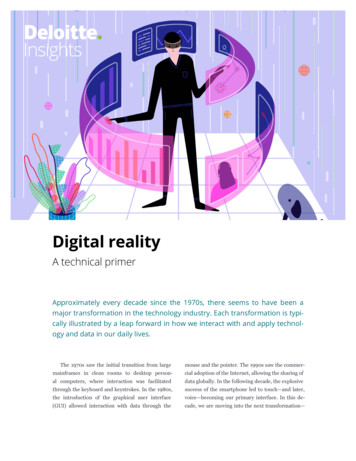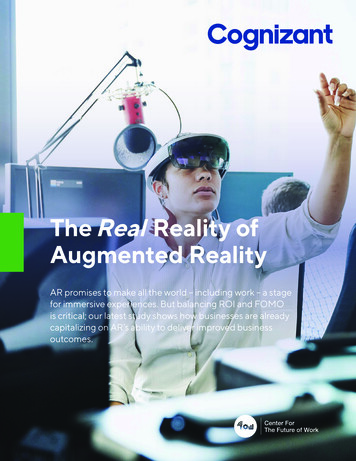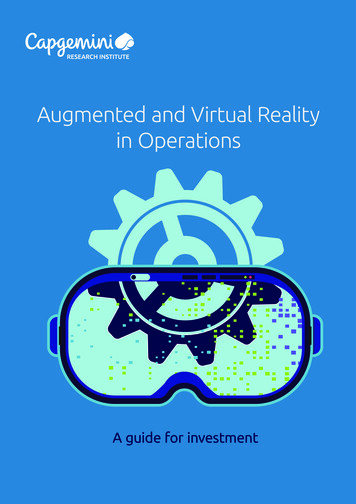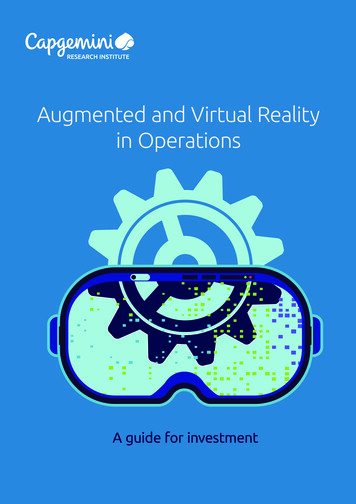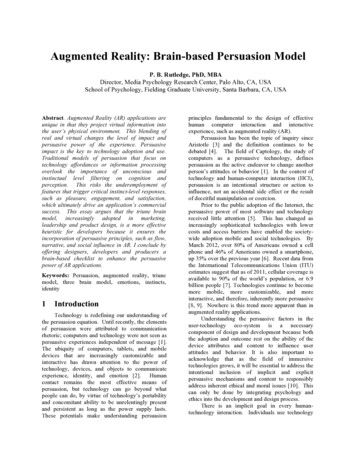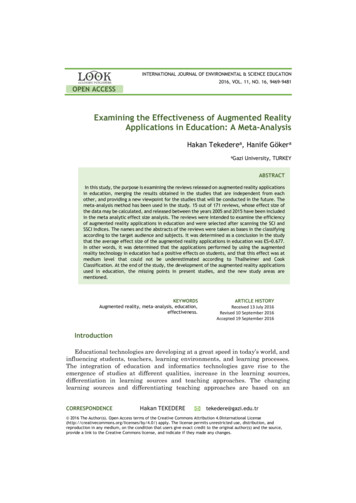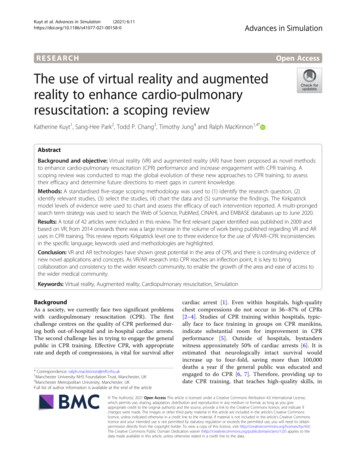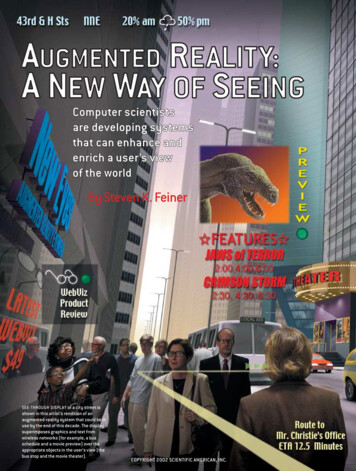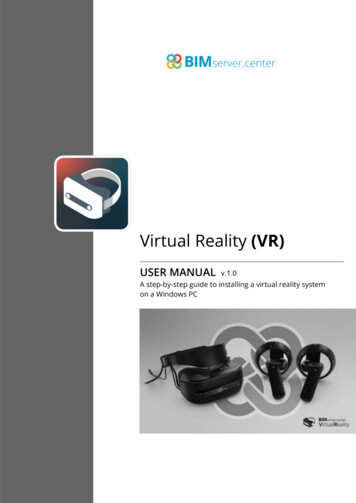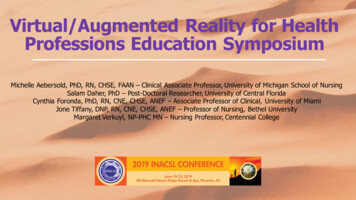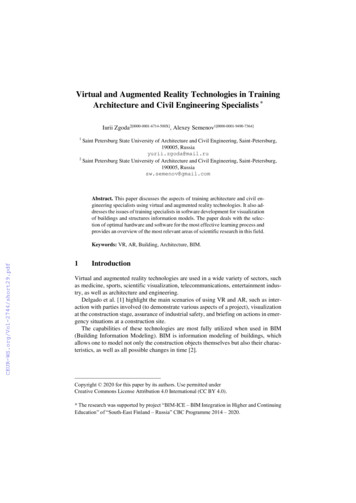
Transcription
Virtual and Augmented Reality Technologies in TrainingArchitecture and Civil Engineering Specialists *Iurii Zgoda2[0000-0001-6714-500X], Alexey Semenov1[0000-0001-9490-7364]1Saint Petersburg State University of Architecture and Civil Engineering, Saint-Petersburg,190005, Russiayurii.zgoda@mail.ru2Saint Petersburg State University of Architecture and Civil Engineering, Saint-Petersburg,190005, Russiasw.semenov@gmail.comAbstract. This paper discusses the aspects of training architecture and civil engineering specialists using virtual and augmented reality technologies. It also addresses the issues of training specialists in software development for visualizationof buildings and structures information models. The paper deals with the selection of optimal hardware and software for the most effective learning process andprovides an overview of the most relevant areas of scientific research in this field.Keywords: VR, AR, Building, Architecture, BIM.1IntroductionVirtual and augmented reality technologies are used in a wide variety of sectors, suchas medicine, sports, scientific visualization, telecommunications, entertainment industry, as well as architecture and engineering.Delgado et al. [1] highlight the main scenarios of using VR and AR, such as interaction with parties involved (to demonstrate various aspects of a project), visualizationat the construction stage, assurance of industrial safety, and briefing on actions in emergency situations at a construction site.The capabilities of these technologies are most fully utilized when used in BIM(Building Information Modeling). BIM is information modeling of buildings, whichallows one to model not only the construction objects themselves but also their characteristics, as well as all possible changes in time [2].Copyright 2020 for this paper by its authors. Use permitted underCreative Commons License Attribution 4.0 International (CC BY 4.0).* The research was supported by project “BIM-ICE – BIM Integration in Higher and ContinuingEducation” of “South-East Finland – Russia” CBC Programme 2014 – 2020.
2 I. Zgoda, A. SemenovIn practice, BIM technologies are used throughout the life cycle of a building orstructure, i.e. during data collection, design, construction, operation, repair, and dismantling.Thus, a BIM model includes both the geometric component and large volumes ofmetadata describing in detail each component of a building or structure being designed.Various scenarios for visualizing these metadata using VR and AR are available.For example, a BIM model may contain information on building erection over a timeperiod (4D-BIM) [3] making it possible to illustrate the stages of a building or structureconstruction project. A BIM model may include MEP components [4] allowing forvolume rendering of heat carrier or air flows in the building.A BIM model is a single repository of information about various sections of thedesigned building or structure, making it possible to automate the process of preparingvisualizations using virtual and augmented reality technologies without the need forprocessing the BIM model in a 3D editor or writing program logic [5].This paper addresses the application of virtual and augmented reality technologieswithin the educational process — both during training BIM specialists (which is anintegral part of the educational process at the Saint Petersburg State University of Architecture and Civil Engineering) and specialists for development of interactive visualizations using VR and AR, trained by the Department of Information Technologies ofthe Saint Petersburg State University of Architecture and Civil Engineering.The authors discuss the issue of choosing equipment for optimizing the educationalprocess. They proved recommendations for the selection of visualization software andthe development of interactive visualizations of BIM models. The paper also discussesthe prospects for integration of virtual and augmented reality technologies and BIMmodeling in Russia, and, in particular, at the Saint Petersburg State University of Architecture and Civil Engineering.2Hardware equipmentCurrently, virtual reality equipment can be divided into desktop and standalone solutions. Desktop solutions are represented by Head-Mounted Displays to be connected toa computer. Oculus Rift S, HTC Vive Pro, Vive Cosmos Plus, and Microsoft MixedReality (MMR) HMDs are among the most popular hardware solutions in this sector.Oculus Quest and HTC Vive Focus Plus are the most relevant standalone solutions.Desktop solutions enable a user to utilize the computing capabilities of a computer(which in most cases outperform the computing capabilities of a standalone HMD) forvisualization. If interaction with BIM modeling software in virtual reality is required,desktop HMDs do not need any additional actions to transfer visualization to a virtualreality device. In case of using a standalone HMD, visualizations are streamed to thedevice or a BIM model in an intermediate format is transferred to the device and visualized using the computing capabilities of the HMD (a similar solution is described byZgoda and Shumilov [5]).A distinctive feature of a standalone HMDs is that they do not require any additionalcomputing devices for running. Such devices can independently generate a stereo image
Virtual and Augmented Reality Technologies in Training Architecture 3and process user input using the built-in computing capacities. This means that theirintegration into the educational process does not require updating computer classrooms.The disadvantage of such solutions is that their processing power is inferior to theprocessing power of a desktop HMD connected to a powerful computer, as well as thefact that initially, it was impossible to use a standalone HMD for debugging VR applications. Interactive visualization development environments such as Unity or UnrealEngine allow for real-time debugging of interactive visualizations in situations wherea desktop HMD is connected to a computer, which significantly speeds up the implementation of new features and troubleshooting. Standalone HMDs are autonomous solutions. It means that for debugging we need to build an application in the APK installation format (most standalone HMDs are based on Android OS), transfer the APK fileto the HMD, install the application, and run it. Only after that, it would be possible todebug the application being developed. This complicates and slows down the processof developing interactive visualizations for standalone devices.Recently, it has become possible to connect virtual reality devices to a computer anduse them as desktop HMDs. Oculus Quest is connected via a USB 3.0 cable, and HTCVive Cosmos Plus is connected via Wi-Fi.For this reason, the paper considers standalone devices as more universal. DesktopHMDs have slightly better performance characteristics, however, the impossibility touse them without connecting to a personal computer significantly limits their application.HTC solutions (both standalone and desktop) represent solutions for the corporatesector, and therefore they are significantly more expensive compared with similar devices by Oculus. The eye-tracking feature available to HTC users can be used in theeducational process [6], however, such a feature was not much needed in trainingcourses at the Saint Petersburg State University of Architecture and Civil Engineering.Wireless connection to a computer for HTC devices is more convenient compared withusing USB cables for Oculus devices, however, wireless transfer of video between acomputer and an HMD may require upgrading the wireless network in the computerclassrooms. In this case, one USB 3.0 port is enough to connect an HM to a computervia a USB cable. Moreover, wireless connection between a computer and an HMD forHTC is an additional feature requiring an appropriate HTC subscription.Therefore, the simplicity of setting up and maintaining Oculus solutions, as well asthe significantly lower price of these devices, make Oculus Quest an optimal solutionfor educational purposes.Smartphones, tablets, Android emulators, or special AR glasses can be used for training architecture and civil engineering students using augmented reality technology (aswell as training specialists in the development of AR applications). As for iOS devices,it is inexpedient to use those for training purposes due to the peculiarities of the Appledeveloper license.At the time of writing this paper, only a very small number of augmented realityglasses could visualize 3D models using augmented reality. Most of these glasses onlydisplay some supporting information in the form of flat images or animations. According to the data sheet of one of the most popular AR development libraries — Vuforia[7], only three models of augmented reality glasses can be used with this library.
4 I. Zgoda, A. SemenovMixed reality solutions such as Magic Leap or Hololens provide significantly greatervisualization compared with smartphones or tablets. However, their price is extremelyhigh, and the demand for these devices in training architecture and civil engineeringstudents is small (since these solutions are aimed at supplementing the real world withvirtual objects, it is possible to make the most of them during building construction oroperation but not at the design stage). The process of development regarding these devices in Unity and Unreal Engine development environments differs slightly from thedevelopment of mobile augmented reality applications using ARCore.Thus, we suggest using Oculus Quest for training specialists in architecture, civilengineering, BIM and development of interactive visualizations using virtual realitytechnology. To ensure training using augmented reality technology during the educational process, any Android-based device supporting ARCore augmented reality technology will do.The most important features for visualization using augmented reality are displayquality and computing capabilities of the device used. Display quality affects the comfort of training. Device performance determines the complexity of BIM models visualized. As part of this study, a Samsung Galaxy S8 smartphone was tested to visualizeBIM models, which demonstrated a consistently high frame rate during the visualization of BIM models designed by students when performing their individual tasks. Fig.1 shows an example of the visualization of a BIM model using markerless augmentedreality.Fig. 1. Visualization of a BIM model using augmented reality3BIM model visualization softwareStudies [8] show that the use of virtual and augmented reality technologies when training architecture and civil engineering students can significantly increase the effectiveness of training. Therefore, BIM models of buildings and structures designed by students need interactive visualization.
Virtual and Augmented Reality Technologies in Training Architecture 5Current solutions for the automated visualization of BIM models can be divided intotwo groups: those aimed only at visualization and those aimed at visualization usingmetadata. Solutions aimed at visualization provide a user with visualization quality upto photorealistic (Lumion, Twinmotion, etc.), and make it possible to study the designedbuilding using virtual reality technology (however, without the support of augmentedreality). These solutions are designed for desktop VR since they provide highly realisticvisualization.Solutions capable to display metadata allow users not only to visualize the geometriccomponent of the designed building but also to display metadata for various elementsof the model (Enscape, IrisVR, Insite VR, the domestic ConceptVR solution). Amongthe above solution, only Enscape is a desktop VR solution; the rest can be used withboth standalone HMDs and desktop HMDs. However, their ability to work withmetadata is limited to displaying metadata for specific building elements.At the moment, only a limited number of solutions make it possible both to displaymetadata for specific building elements and also optimize visualization in accordancewith these metadata (e.g. visualizing heat carrier flow movement in pipes based onMEP metadata [9]).It should be noted that of all the above solutions only ConceptVR officially supportsthe domestic Renga BIM software. Other solutions can visualize Renga models only byusing intermediate export formats. All the above solutions (except for Twinmotion having an educational license) are extremely expensive.In this regard, we consider Twinmotion for photorealistic visualization of BIM models for students training. The Department of Information Technologies of the Saint Petersburg State University of Architecture and Civil Engineering proposed a hardwareand software package [5] to visualize BIM models (including those designed with thedomestic Renga software) using virtual and augmented reality technologies to studyBIM models with metadata and MEP visualization.4Interactive visualization development toolsCurrently, many software systems for the development of interactive visualizations areavailable. In certain situations, developing a solution from scratch can be effective.Nevertheless, the training course taught at the Saint Petersburg State University of Architecture and Civil Engineering currently lacks OpenGL, Vulkan or DirectX modules,therefore, students master tools for developing interactive visualizations during a corresponding course.At the moment, the most common are Unity and Unreal Engine 4. In addition tothose, there are other solutions, such as the domestic Unigine engine, the actively developing open-source Godot engine, CryEngine engine and its Amazon Lumberyardbranch.Unigine has become available to a wide range of users relatively recently and, therefore, requires a comprehensive detailed study to determine its applicability in the educational process. Godot is actively developing, which significantly complicates theteaching process. It is almost not used in a commercial environment, which makes it
6 I. Zgoda, A. Semenovinsufficiently relevant for specialist training. CryEngine and Lumberyard (as well asUnigine) currently do not provide development for mobile devices (which is necessaryfor studying augmented reality and standalone VR technologies). As a result, studentsneed to master two separate engines during the course, which is impractical. Hence,this paper compares only Unity and Unreal Engine.Currently, Unity and Unreal Engine have a similar component architecture, providea high level of realistic visualization, support a number of intermediate formats, and arecross-platform (in terms of both the type of OS used for development and target platforms).The Unity developer community is one of the largest and significantly outnumbersthe similar Unreal Engine developer community. Moreover, Unity also offers its usersmuch more comprehensive documentation. This greatly simplifies the search for information for students when they perform their individual tasks. The Unreal Engine documentation is quite detailed in a number of aspects. However, many highly specializedUnreal Engine components (such as procedural geometry generation, serialization,cross-platform file system API) are basically undocumented, and therefore informationsearch for implementing any non-trivial functionality turns out to be more complicatedcompared with Unity.Unity also provides a faster iteration process. The software products use C# programming language, the code is executed in a virtual machine, and errors during program operation do not result in an abnormal end of development or interactive visualization. Moreover, compiling the code takes several seconds. Assembling a project asan executable file (for desktop systems) or an installer (for mobile devices) takes onaverage no more than a minute (for projects implemented by students as part of theirterm papers).Unreal Engine offers users two development options. Using Blueprints visual programming language allows them to compile code in a fraction of a second. Besides,Blueprints is executed in a virtual machine, which isolates errors in the code and prevents emergency completion. Unfortunately, the use of visual programming means thatalthough it is possible to implement something complicated in terms of writing softwarecode, it is not too convenient.Using C in Unreal Engine requires code coverage with a lot of auxiliary macros.There is no virtual machine, so any error (e.g. accessing an incorrect memory address)results in emergency completion of both visualization and the entire engine operation.The average compilation speed with minimal changes in the code is measured in tensof seconds. Assembling projects takes many minutes, which significantly slows downthe educational process.Cross-platform development is available in both engines, but Unreal Engine has significantly more restrictions. Given that at the moment there is no possibility of debugging augmented reality applications in an editor (both in Unity and Unreal Engine),development and debugging during independent work with Unreal Engine requires toomuch time, which negatively affects the effectiveness of the training process.With a view to the above, Unity is a preferable tool when training specialists in thedevelopment of interactive visualizations in architecture and civil engineering, and, inparticular, in the field of BIM. Unreal Engine offers a number of advantages, such as
Virtual and Augmented Reality Technologies in Training Architecture 7out-of-the-box photorealistic graphics (an example of visualizing a BIM model usingUnreal Engine is shown in Fig. 2), the ability to use easier-to-learn visual programming,a large library of 3D modeling materials available to developers, and a number of features that are not available in Unity. In this regard, Unreal Engine 4 can be used tointroduce architecture and civil engineering specialists to the development of interactive visualizations of BIM models.Fig. 2. Visualization of a BIM model using Unreal Engine 45Studies on the integration of VR/AR technologies and BIMBIM technologies, as well as virtual and augmented reality technologies, are activelydeveloping. Therefore, this field of scientific knowledge in Russia has a large numberof unexplored areas. It is being actively promoted at the Saint Petersburg State University of Architecture and Civil Engineering, where a number of studies are being carriedout to expand the capabilities of virtual and augmented reality technologies in the BIMcontext.In recent years, the Department of Information Technologies of the Saint PetersburgState University of Architecture and Civil Engineering has been actively studying thepreparation of photorealistic visualizations of BIM models using virtual and augmentedreality technologies [10].A number of studies conducted at the Department are aimed at identifying new nonstandard and effective scenarios for using VR/AR in the BIM context. There are highlyspecialized papers related to the use of virtual reality for safety briefing [11], creationof interactive visualization with the display of energy efficiency parameters of buildings and apartment layouts [12]. More general issues related to the automated
8 I. Zgoda, A. Semenovgeneration of interactive visualizations of BIM models (including MEP, see Fig. 3)using virtual and augmented reality are also considered [5]. Particular attention is paidto supporting domestic Renga BIM software.Fig. 3. Visualization of a BIM model with MEP display6ConclusionIn the course of the study, we performed the comparative analysis of the solutions forvirtual and augmented reality technologies, their advantages and disadvantages in thecontext of training BIM and interactive visualization specialists. We also reviewed theissues of choosing software tools for visualizing BIM models and development environments for interactive visualizations, and described the most promising areas of research for this subject at the Saint Petersburg State University of Architecture and CivilEngineering.We recommend Oculus Quest HMDs as training equipment with the use of virtualreality technologies because of their easy setup, accessibility and no need for highperformance computers. We also recommend Android smartphones with ARCore technology support as training equipment with the use of augmented reality technology,characterized by high computing power for real-time visualization of BIM models andhigh-quality display.Unity and Unreal Engine interactive visualization development environments arerecommended for training specialists in the development of interactive visualizationsof buildings and structures. Unreal Engine offers visualization quality close to photorealism and visual programming tools that simplify the process of developing programlogic for specialists without a profound knowledge of programming. Unity is currentlyan optimal development environment for training specialists with programming skillsin high-level languages, for whom programming and creation of interactive components will be the main focus in the development environment.
Virtual and Augmented Reality Technologies in Training Architecture 97AcknowledgmentsThe research was supported by project “BIM-ICE – BIM Integration in Higher andContinuing Education” of “South-East Finland – Russia” CBC Programme 2014 –2020.References1. Davila Delgado, M., Oyedele, L., Demian, P., Beach, T.: A research agenda for Augmentedand Virtual Reality in Architecture, Engineering and Construction. 45 101122 . Milyutina, M.A.: Introduction of Building Information Modeling (BIM) Technologies inConstruction. JPhCS, 1015(4), 042038, 4 pp. (2018).3. Jupp, J. 4D BIM for environmental planning and management. Procedia engineering, 180,pp. 190-201 (2017).4. Khanzode, A, Fischer, M, Reed, D. Benefits and lessons learned of implementing BuildingVirtual Design and Construction (VDC) technologies for coordination of Mechanical, Electrical, and Plumbing (MEP) systems on a large Healthcare project. Journal of InformationTechnology in Construction, 13, 19 pp (2008).5. Zgoda, Iu.N., Shumilov, K.A.: Markerless Augmented Reality in BIM-Model Visualization.Proceedings of III International Conference “BIM in construction & architecture”, pp. 217222 (2019). https://doi.org/10.23968/BIMAC.2020.0286. Rahman, Y., Asish, S.M., Khokhar, A., Kulshreshth, A.K., Borst, C.W.: Gaze data visualizations for educational VR applications. Symposium on Spatial User Interaction (2019).https://doi.org/10.1145/3357251.33587527. Vuforia Engine for Digital Eyewear .html. Last accessed 1 Jul 2020.8. Sun, C., Wei, H., Diqiong, X.: Navigation modes, operation methods, observation scales andbackground options in UI design for high learning performance in VR-based architecturalapplications. Journal of Computational Design and Engineering 6.2, pp. 189-196 . Fuzor https://www.kalloctech.com/index.jsp. Last accessed: 01.07.20.10. Zgoda, Iu.N., Semenov, A.A., Shumilov, K.A.: Development of photorealistic interactiveBIM-model visualization with use of virtual and augmented reality technologies. New information technologies in architecture and civil engineering. Conference proceedings, pp.24 (2018).11. Shakshak, O.M., Subbotina, N.A., Tsaplin, V.V.: Interactive digital model as a modernteaching method. IV All-Russian Scientific and Practical Conference with international participation “Safety in construction”: conference proceedings, pp. 32-40 (2019).12. Shakshak, O.M., Evsikov, I.A.: Multifunctional VR application based on digital buildingmodel. Architecton: Proceedings of Higher Education, 4 (68), 11 pp. (2019).
engineering, BIM and development of interactive visualizations using virtual reality technology. To ensure training using augmented reality technology during the educa-tional process, any Android-based device supporting ARCore augmented reality tech-nology will do. The most important features for visualization using augmented reality are display
